What are the signs and symptoms of Osteoporosis? How can we detect it in the early stages? - Dr Abhishek Patil

Osteoporosis is often referred to as the silent thief of bone health. It poses a significant risk to millions worldwide. It has no presentations, and individuals are typically not limited to pain. In some instances, it is advanced until a fracture arises and leads to permanent damage.
Nevertheless, it should be noted that osteoporosis has only vague pain all over the body, contradicting its characteristics. Early detection and prevention can highly reduce the disease's impact.
Understanding Osteoporosis
Before moving on to its symptoms and indicators, let's grasp what osteoporosis entails. Bones, as living tissues, undergo a continuous process of breakdown and renewal. Osteoporosis leads to low bone density and quality, which happens when creation of new bone does not keep up with deterioration of old bone.
In general, men and women achieve their highest bone density in their twenties and start losing it from that age. This process is accelerated many fold in females soon after hitting the menopause, and hence women are prone to this condition compared to male counterparts.
Alcohol consumption, family history, long-term steroids, cancer, low body mass index, and inflammatory diseases like rheumatoid arthritis are among the factors that contribute to osteoporosis. This results in fragile bones that are prone to breaking, even from minor falls or bumps.
Common signs and symptoms to watch out for
- Bone Fractures (hallmark of osteoporosis): They may occur with minimal trauma or even during routine activities, such as bending or lifting, especially in areas like the spine, hip, wrist, and forearm.
- Loss of Height: Vertebral fractures due to osteoporosis can cause a gradual loss of height or a stooped posture (kyphosis) as a result of spine compression.
- Back Pain: It is often localized and can worsen with movement or activity, causing persistent, dull, or severe back pain indicating vertebral fractures.
- Bone Deformities: In severe cases, osteoporosis can alter the body's alignment and function due to bone deformities, particularly in the spine or wrists.
- Receding Gums and Tooth Loss: Osteoporosis may affect the jawbone, causing receding gums and tooth loss.
- Brittle Nails: Easily breakable and brittle nails may be subtle signs of reduced bone density.
- Decreased Grip Strength: Compromised bone health can lead to weakened grip strength or difficulty gripping objects.
Early Detection
In osteoporosis, early detection can prevent fractures and minimize its impact on daily life. Here's how to detect osteoporosis early:
- Bone Density Test (DEXA Scan): The gold standard for diagnosing patients with osteoporosis is the DEXA test. A DEXA examination is a painless, non-invasive test that measures bone mineral density and calculates a person’s likelihood of developing a fracture. The recommended age for a DEXA test is women above 65 years and men above 70 years, and those below with various risk factors as mentioned above. According to WHO, a person with a T score of less than or equal to -2.5 on spine and/or hip BMD (these scores would be indicated on the DEXA scan report) is termed as having osteoporosis.
- Clinical Assessment: A comprehensive evaluation such as understanding the patient’s medical history, physical examination, and assessment of risk factors like age, sex, family history, lifestyle factors, and previous fractures can also help detect osteoporosis.
- Fracture Risk Assessment: Based on clinical risk factors and bone mineral density, tools like FRAX (Fracture Risk Assessment Tool) can calculate the 10-year probability of a major osteoporotic fracture and hip fracture.
- Blood Tests: Blood tests are performed to assess calcium, vitamin D, and hormone levels, which play crucial roles in bone health.
Prevention and Management
Osteoporosis can’t always be prevented. However, prevention and management strategies are crucial for maintaining bone health and reducing fracture risks. These include:
- Healthy Diet: Consume a balanced diet rich in calcium and vitamin D. If necessary, include dairy products, leafy greens, fortified foods, and supplements in your diet plan.
- Regular Exercise: Engage in regular weight-bearing exercises.
- Lifestyle modifications: Maintain a healthy weight and abstaining from smoking and excessive alcohol consumption.
- Medications: Certain medications (bisphosphonates, hormone therapy, or other bone-building drugs) are prescribed by healthcare providers based on the severity of osteoporosis.
- Fall prevention: Measures like removing hazards at home and ensuring adequate lighting and footwear can further mitigate risks.
Conclusion
In conclusion, proactive measures, coupled with timely medical intervention, are vital in managing osteoporosis effectively. By recognizing symptoms early, undergoing regular screenings, and adopting preventive strategies, individuals can safeguard their bone health and maintain an active lifestyle in the long run.
Disclaimer: The views expressed in this article are of the author and not of Health Dialogues. The Editorial/Content team of Health Dialogues has not contributed to the writing/editing/packaging of this article.


